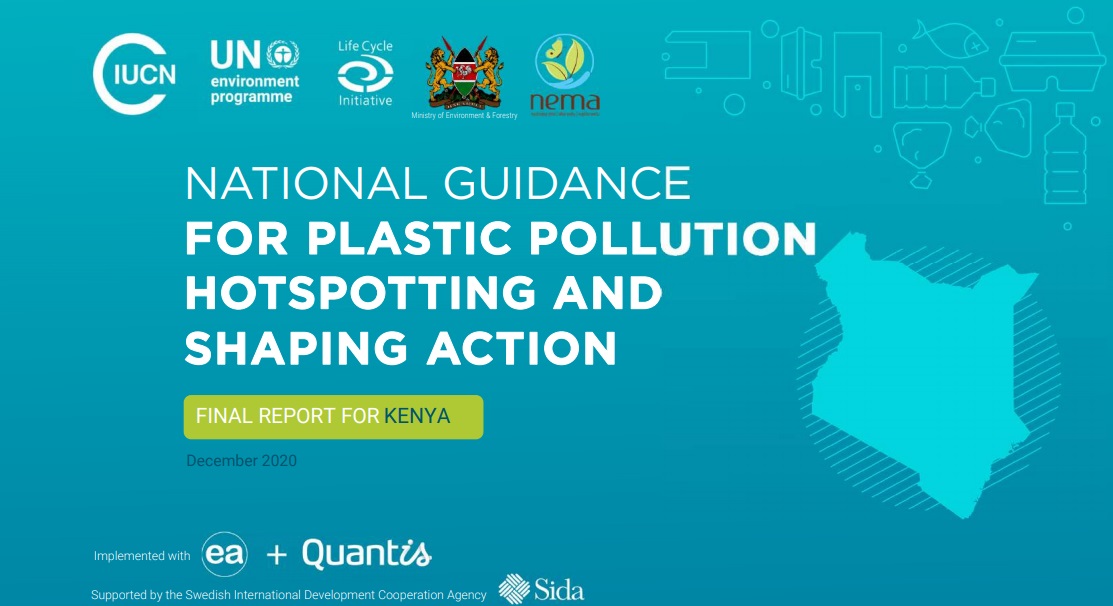As UNEA5 kicks off, ground-breaking Plastic Pollution Hotspotting Results Published for Seven Countries in Asia, Africa, and the Mediterranean
During this week’s United Nations Environment Assembly (UNEA5), there is a focus on marine plastic pollution which continues the discussions that began at UNEA 1 in 2014. In order to mitigate plastic pollution, countries need to be able to identify where and how the plastic pollution is occurring. The publication of ground-breaking work by IUCN Plastics with UNEP in seven countries to date demonstrates a methodology that allows countries to find and understand the scope of plastic pollution hotspots by polymer type, sector, application, region, and waste management areas– including assisting national governments to formulate clear actions to reduce plastic leakage.

Photo: IUCN
We know that plastic pollution to our ocean is a problem:
-
Over 300 million tons of plastic are produced every year for use in a wide variety of applications.
-
At least 12 million tons of plastic end up in our ocean every year, and make up 80% of all marine debris found from surface waters to deep-sea sediments.
-
Marine species ingest or are entangled by plastic debris, which causes severe injuries and deaths.
-
Plastic pollution threatens food safety and quality, human health, coastal tourism, and contributes to climate change.
Based on a projected annual increase in global plastic production of 4%, the importance of a harmonised methodology to detect plastic waste and leakage, and their associated impacts, is critical. Identifying and addressing the challenge of plastic leakage requires stakeholders from various levels to join forces to understand and benchmark the leakage hotspots and bridge the data and knowledge gaps. “Where is it leaking, what is leaking, how is it leaking, and why is it leaking?” are the key questions to ask when approaching a plastic pollution assessment, whether it is at municipal or national level.
The IUCN-UNEP National Guidance on Plastic Pollution Hotspotting and Shaping Action and its associated tools are the basis of national hotspot assessments for Kenya, Mozambique, South Africa, Thailand and Viet Nam, and were also applied in Cyprus and Menorca.
These seven studies were part of a systemic approach to address plastic waste and leakage, and used the available data and information for the research. Each study identified a range of plastic leakage hotspots at the country level. The reports provide a visual analysis and key interpretations across five categories in which plastic leakage hotspots are prioritised. Interventions and instruments to begin to change the situation are included in the reports for consideration by national decision makers and sector practitioners. The proposed interventions are meaningful actions based on the actionable hotspots and, with the example instruments, give national decision makers a means to implement and monitor progress of suggested interventions.
The primary aim of the reports is to demonstrate the areas where actions can be taken to address plastic leakage – providing guidance, tools, and examples to close the plastic tap at the national and regional level. The Guidance and the pilot reports can be used as national baseline for other countries. The reports were created with input and a review of results from national stakeholders during virtual workshops in 2020.
Key Takeaways by Country:
-
More than 98% of the plastic that is consumed in Kenya is imported, either in the form of product or in the form of primary virgin plastic
-
In 2018, the per-capita plastic waste generation in Kenya is of 11 kg/year, which is below the global average of 29 kg/cap/year*, but matches the average for Easter and Southern Africa of 12 kg/cap/year*.
-
In Kenya, 37 thousand tonnes of plastic leak to the ocean every year. This is only a small fraction of the mismanaged waste, which reaches 465 thousand tons per year.
-
There is no domestic production of plastic in Mozambique, all plastic consumed is imported.
-
The average plastic waste generated per capita is 6.1 kg/capita/year, which is much smaller than the world average plastic waste generation of 29 kg/capita/year.
-
In Mozambique, around 17 kt of plastic waste is leaking into rivers and the ocean. This means that 10% of plastic waste generated is leaking into the marine environment. This is equivalent to an individual leakage of 0.6 kg/capita/year.
-
Almost all plastic that is consumed in South Africa is manufactured in the country from locally produced or imported primary or secondary plastic.
-
Per capita plastic waste generation is around 41 kg/cap/year which is above the global average of 29 kg/cap/year.
-
In South Africa, 79 thousand tonnes of plastic leak to the ocean and main rivers every year. This leakage corresponds to 3% the quantity of plastic waste generated in the country per year.
-
Thailand is a producer and exporter of plastic: more than half of the plastic produced (or imported) in Thailand ends up being exported.
-
The average per capita plastic waste generation is 74 kg/capita/year, more than twice the world average of 29 kg/capita/year (in 2018).
-
In Thailand, 336 thousand tonnes of plastic leaks to the ocean every year. This is equivalent to a plastic leakage of 4,8 kg/capita/year.
-
Currently, Vietnam imports most of the plastic it consumes.
-
The average per capita plastic consumption is 81 kg/person/year, of which 58 kg/capita/year go to waste and 23 kg/person/year go to increase the stock (due to high industry growth in recent years).
-
In Vietnam, 453 kt of plastic waste leaked into the ocean in 2018. This is equivalent to a plastic leakage of 4,7 kg/capita/year.
-
10 220 tonnes of plastic waste generated in Menorca in 2018, from which 2476 tonnes (24%) are attributed to the tourism sector.
-
Plastic waste generation per capita amounts to 111 kg/cap/year (including tourists on annual basis).
-
78 tonnes of plastic leak into waterways from Menorca in 2018, including 19 t (24%) attributed to the tourism sector. This corresponds to a 1% leakage rate and 0,8 kg/cap/year leakage per capita.
-
92’588 t of plastic waste generated, from which 10’495 t are attributed to tourism.
-
Plastic waste generation per capita amounts to 94 kg/cap/year, well above the Western Europe average (64 kg/cap/year).
-
756 tonnes of plastic leak into waterways in 2018, including 86 tonnes from the tourism sector. This corresponds to 1% leakage rate and 0,8 kg/cap/year leakage per capita.
These reports were implemented by Quantis EA, and realised through generous support of the Swedish International Development Cooperation Agency, Sida., and the Didier et Martine Primat Foundation
 Photo: SIDA
Photo: SIDA
 Photo: IUCN
Photo: IUCN
 Photo: IUCN
Photo: IUCN
These project reports are part of the IUCN Close the Plastic Tap programme.
If you wish to know more about applying the Guidance, please reach out to us:
UNEP: Feng.Wang@un.org
IUCN: Lynn.Sorrentino@iucn.org
About MARPLASTICCS
In 2017, with generous support from the Swedish International Development Cooperation Agency (Sida), IUCN launched the Marine Plastics and Coastal Communities initiative (MARPLASTICCs), an initiative in Africa and Asia that works in five countries: Kenya, Mozambique, South Africa, Thailand, and Viet Nam. The project consists of four pillars: capacity building through circular economy projects, production of knowledge products – including the national guidance and reports on plastic pollution hotspotting, economic and regulatory policy analysis in each country, and connecting with the private sector with a business component to help businesses identify plastic leakage in their value chains.
To learn more, please visit: https://www.iucn.org/theme/marine-and-polar/our-work/close-plastic-tap-programme/marplasticcs
About Marine Litter in the UN Environmental Assembly and UNEA5
The United Nations Environment Assembly (UNEA) is the world’s highest-level decision-making body on the environment, with a universal membership of all 193 Member States. UNEA 5 takes place 22-26 February 2021 in Nairobi, Kenya. The ad hoc open-ended expert group on marine litter and microplastics was established at the third session of the UN Environment Assembly in response to UNEP/EA.3/Res.7 Marine Litter and Microplastics. At the fourth session of UNEA, the mandate of the expert group was extended, pursuant to operative paragraph 7 of resolution UNEP/EA.4/Res.6 Marine plastic litter and microplastics



